Topics
Observatories of Mauna Kea
June 22, 2001
Part II - The Submillimeter & Radio Telescopes
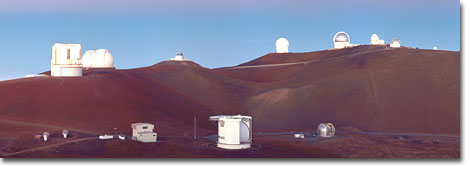
Last month, we discussed the optical and infrared telescopes of Mauna Kea. This month, we continue our discussion with a look at the submillimeter and radio telescopes.
The summit of Mauna Kea is considered by many to be the best site for astronomical observations in the world. With approximately 220 clear nights every year, a stable, dry atmosphere which results in sharp images, and no major cities nearby to affect the night sky, it has been chosen as the site for many different telescopes.
Just below the summit ridge which hosts the optical-infrared telescopes is "Millimeter Valley", where three telescopes observe radiation with wavelengths of about 1 mm (about 2000 times longer than visible light). Such radiation is emitted by material which is only a few tens of degrees above absolute zero.
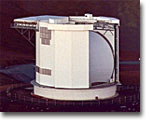
At 15 meters across, the James Clerk Maxell Telescope (JCMT) is the largest telescope in existence that's capable of working at submillimeter wavelengths. The main dish is composed of 276 aluminum panels carefully adjusted to maintain its precise shape. To protect the telescope from wind and dust during observations, a huge piece of Gore-Tex fabric (nearly transparent to millimeter radiation) is stretched in front of the dish. This screen also enables the telescope to point at, or very close to, the Sun without damaging the dish. The JCMT (along with UKIRT, discussed last month) is operated by the Joint Astronomy Centre.
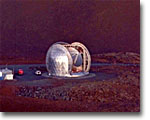
The Caltech Submillimeter Observatory (CSO) is a 10.4-meter segmented dish operated by the California Institute of Technology under a contract from the US National Science Foundation. The CSO began operating in 1988, one year after the JCMT was completed, and the two telescopes have recently been linked together to operate as an interferometer. The technique of interferometry has been used for many years in radio astronomy (where it is much easier due to the longer wavelengths of the radiation), and has recently become practical at millimeter and optical wavelengths. By combining telescopes with interferometry, one can mimic a single telescope with a mirror/dish as big as the distance separating the two furthest telescopes. Although the total signal gathered is still only the sum of what is coming from each of the component mirrors/dishes, the gain in sharpness can be much greater. A single telescope cannot produce images sharper than its diffraction limit, which is inversely proportional to the diameter of the primary mirror (i.e., an 8-m telescope can produce images twice as sharp as a 4-m telescope can); however, the sharpness of the images produced by an interferometer is set by the largest distance between its component dishes, which, for the CSO and the JCMT, is 158 meters. The images produced by the CSO/JCMT interferometer are therefore 10 times sharper than those produced by the JCMT alone.
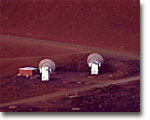
The Submillimeter Array (SMA), still being constructed beside the JCMT and below Subaru, is a collaborative project of the Smithsonian Astrophysical Observatory and the Institute of Astronomy and Astrophysics of the Academia Sinica of Tawian. When completed, the SMA will consist of eight 6-meter dishes which will operate together as an interferometer to produce images approximately 100 times sharper than a single dish could produce. It is also anticipated that the SMA will be linked with the JCMT and/or CSO to further increase the power of the array. (The large building between the SMA site and the JCMT is where the individual antennae are assembled and serviced.)
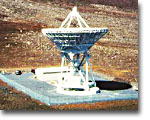
The final telescope on Mauna Kea is located some distance below the summit. It is an antenna belonging to the Very Long Baseline Array (VLBA), operated by the US National Radio Astronomy Observatory (NRAO). The VLBA was constructed between 1986 and 1993 and consists of ten 25-meter antennas located throughout the US, including 8 on the mainland and one in the US Virgin Islands, 8600 km (5000 miles) away from Hawai`i. These operate together as an interferometer with a resolution which can exceed 0.001 arcseconds, equivalent to seeing a person on the Moon or reading a newspaper in New York from Los Angeles.
Used individually and in concert, the telescopes of Mauna Kea are one of the world's most powerful tools for understanding the complexities and beauty of the nighttime sky.